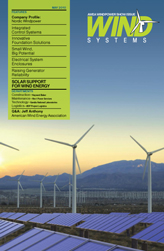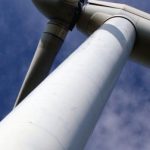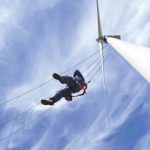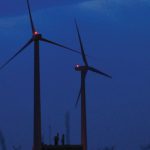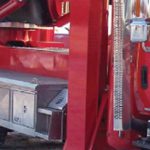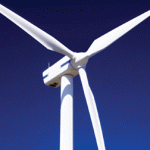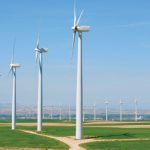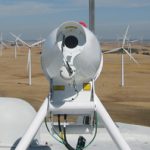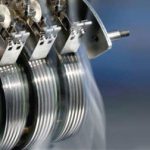Enclosures form an integral part of a wind energy circuit protection system in which circuit integrity has to be provided. Typically the enclosure is a container for electrical controls, acting as a safeguard against tampering and providing environmental protection of the electrical connection. It can be made from metal or non-metallic material, but it must serve its protective function for the life of the installation, so durability is key. There are three typical types of enclosure materials available: metal, plastic, and composite.
Metal: Common metal enclosure choices include carbon steel, stainless steel, and aluminum, with carbon steel being the most prominent choice based on its low initial cost. Carbon steel is typically galvanized or painted to prolong the service life. Premium metals such as stainless steel and aluminum are used where long life, corrosion resistance, and weatherability are critical, such as protecting controls for junction boxes for wind installations.
Plastic: Thermoplastics such as polycarbonate, polyester, and PVC offer a degree of corrosion protection beyond painted carbon steel. Thermoplastics, though, are more susceptible to UV and weathering degradation over time. Certain stabilizers can be added, but ultimately the nature of the thermoplastics will yield to extended weathering.
Composite: Thermoset materials such as a polyester resin combined with glass create a unique composite FRP (Fiberglass Reinforced Polyester) that is exceptionally durable and weather resistant (Figure 1). Like thermoplastics FRP provides a greater degree of corrosion than painted carbon steel, yet will perform better in more harsh environments.
There are risks associated with improper enclosure selection, including failure. Enclosure failures caused by environmental corrosion or impact damage resulting in a breach of proper sealing can cause a multitude of problems ranging from catastrophic and dangerous system collapses, production downtime, and increased maintenance costs, in addition to losses in customers and revenue. Proper product selection is therefore critical as it relates to both the design and the material of the enclosure.
When choosing an enclosure there are influential factors that will help reduce failure. Selection ultimately comes down to optimal performance and value. Often tradeoffs between performance, acquisition cost, and operating cost are made in the process to find the ultimate choice in a unique application. Consider three factors that influence the enclosure specification for wind applications and how an enclosure might stack up: environmental characteristics; physical characteristics; and material and material utility.
Environmental Characteristics
The foremost motivating characteristic influencing the enclosure choice for wind engineers and specifiers is the environment of the site. This consideration envelops temperature, chemical, moisture, and concern for the physical world of the permanent installation. Whether the environment is hostile or passive, an attempt is made to match the capabilities of the enclosure with the anticipated ambient environment. An over-specified enclosure will work effectively in a natural environment, but there are severe repercussions for using an under-specified enclosure in a hostile environment, thus making the environment the over-riding consideration.
There are environmental conditions that are specific to the wind industry. Corrosive environmental conditions can act as accelerants for corrosion, just as gasoline does for fire. The factors that determine the level of corrosion in an environment include extreme weather conditions such as dust, moisture, ultraviolet radiation, and temperature (spread between the daily high and low temperatures as it influences condensation and evaporation of moisture).
Dust: Dust particles can cling to surfaces and retain moisture. Typical sources of dust include soil/sand, smoke and soot particles, and salts. Depending on the chemical composition of the dust it may contribute to the corrosive attack, or it may act as a catalyst. Even if the dust is chemically inert a concentration cell can be set up under the dust particles due to differential aeration.
Moisture: The level of corrosion typically increases with moisture content. In fact, if there was no moisture there would be no electrolyte, and hence no corrosion. Common atmospheric sources of moisture are rain, dew, and condensation. Rain can have a beneficial effect in that it washes away contaminants from exposed surfaces. If rain collects in pockets or crevices, however, it can be very detrimental because it supplies a source of continued moisture. When relative humidity exceeds 70 percent a thin film of moisture will form on a metal surface, providing an electrolyte. This dew or condensation can become very corrosive if it is saturated with a contaminant like sea salt, or acid compounds from industrial sources.
Ultraviolet Radiation (UV): UV has been a concern with non-metallic manufacturers for many years. The rate at which the UV degradation occurs will vary depending on heat, humidity, and the altitude at which the product is installed (Figure 2). There are also differences in the way UV breaks down differing non-metallic materials. For instance, the effects of UV light become critical more quickly with thermoplastics than with thermosets of similar chemical structure. This happens because thermoplastic materials have a much lower mass (molecular weight) than thermosets, so breaking the bonds in thermoplastics cuts the polymers into much smaller fragments than does each breaking bonds in thermosets. In thermosets the cross-linking limits unzipping the polymer chain and requires more UV energy to break it down, thus giving increased UV resistance and weatherability.
Temperature: Increasing the temperature of a corrosive media will generally increase the rate of corrosion. Temperature gradients on the same piece of metal can create a basic corrosion cell. The part of metal with the higher temperature will become anodic to the area with a lower temperature.
Physical Characteristics
When considering the physical characteristics of an electrical enclosure, there are certain basics to take into consideration. The most notable are:
• Corrosion resistance
• Size
• Weight
• Mounting
• Flammability
• Safety
• Security
• Flexural strength
• Hardness
• Impact resistance
• Tensile strength
• Sunlight (UV) resistance
• Hardness
• Heat transfer
• Radiused edges
• Water absorption
• Available access
• Cabinet design
• Bending radius limitation
Three physical characteristics are particularly important for wind-industry professionals to consider: strength, ultraviolet radiation, and electrical.
Strength: Strength measures the resistance of a material to failure, given by the applied stress or load per unit area, tensile and compression. Strength is a measure of a material’s ability to withstand stretching or compressing under load. On the other hand the toughness of a material is its ability to withstand sudden impacts. Increasing strength, tensile or compression, usually decreases toughness and vice versa. Whereas steels often have high strength they exhibit low toughness, which means they dent easily and are difficult to drill or penetrate. Thermosets and thermoplastics, or composites, exhibit average strength but high toughness, meaning they can withstand sudden impacts and maintain their shape. Today’s composites have improved dramatically, in that they can now be designed for both high strength and toughness via additives and fiber reinforcements.
Ultraviolet Radiation (UV): Many professionals are still unaware of how non-metallic composite materials are able to effectively withstand damage from UV exposure. In enclosure applications a unique formulation is now available to provide superior molded-in UV resistance, requiring no field maintenance and at no additional product cost. It is a double protection formulation technology that significantly enhances the molecular bond strength and cross-linking that occur during the curing process in thermosetting polyester sheet molding compounds (SMC). This new formulation fights polymer degradation by making it much more difficult for UV light to attack molecular bonds of both primary chains and cross-links. This is accomplished by increasing the molecular density of the base resin system, thus increasing its resistance to UV degradation. An additional benefit of this formulation is its use of additives or antioxidants that help protect the polymer chain and resist photo induced oxidation from exposure to UV sunlight.
Electrical: Like the physical, there is concern regarding the protection offered for the installed components as well as protection of the enclosure itself. An enclosure that breaks down over time can no longer perform the duties for which it was specified. Therefore, the following characteristics are important: electrical conductivity, service temperature, thermal conductivity, grounding, and arc resistance.
Material Selection and Utility
If you have the opportunity to select the material, make sure that you have investigated the material and that it is the most appropriate for the type of environment. Every application has its unique demands and elements of this list, and do not follow a precise order. Indeed, many of the capabilities are considered to be inherent in certain material choices. An errant or over-estimated material choice, however, can have many repercussions in the lifecycle of a product. It makes good sense to specify a product that qualifies in almost every category, insuring satisfactory results without regard for the type of installation.
Material utility addresses the consideration for machining, cutting, sawing, drilling, and modifying the material of choice. User preference plays a significant part in this selection, and material familiarity overrides practicality in many instances. A few things to keep in mind for both non-metallic and steel modifications are as follows.
Modifications can be made to non-metallic enclosures that make them particularly useful for a wide variety of situations and applications (Figure 3). Non-metallic composites offer the benefits of part integration and minimization, along with substantial savings in weight. Along with that advantage is a reduction in the requirements for machining operations that need to be performed to complete an assembly. Drilling and cutting operations can’t be avoided completely in all cases, however. There are several types of machining operations that can easily be performed on composites, including turning, drilling, routing, trimming, sanding, and milling. Most of these operations are similar to metal removal techniques, but there are some differences that need to be addressed in order to make clean, high-quality holes and cutouts in composites.
Delaminating of the outer surface and glass fibers directly below the surface are the main failure modes noticed when holes or cutouts are drilled, or cut out improperly. Most of the time excessive edge chipping around the perimeter of the cutout or hole is due to improper tools used and methods applied. A little upfront planning and understanding of the proper methods to machining composites can make all the difference in the final outcome of the operation. Factory-option modification is also a highly desirable alternative for many end users, because it enables the manufacturer to use its skill in providing enclosure modifications and shipping to the customer ready to use.
When approaching stainless modifications, keep the type of tools used in mind. If modifications such as custom sizes or shapes are required, both mild and stainless steel are good candidates. Both are fabricated from a flat sheet of metal, making them easier to form to custom specifications in the fabrication process. Mild steel is a viable option, and with the correct metalworking tool holes can easily be added in the field. Stainless steel, due to its hardness, is very difficult to cut and far more challenging to modify on site. The elements of chrome and nickel provide stainless steel great corrosion resistance to oxidation, but stainless steel can be contaminated by using carbon steel power tools and other tooling equipment. Skilled shops with proper quality control programs and knowledgeable craftsman can prevent stainless steel contamination.
Conclusion
Specifiers for enclosures for wind applications must carefully evaluate all factors to ensure that an enclosure made of any material type will withstand its environment. The process for proper material and enclosure selection begins with a detailed consideration of the application. Each wind environment is unique, and all possible applications should be identified for the intended enclosure application. So start with a simple list of your needs and ask plenty questions, because failure of your enclosure can’t be an option when so many are relying on the wind industry to help reduce our dependence on fossil fuels and reduce CO2 emissions.



















